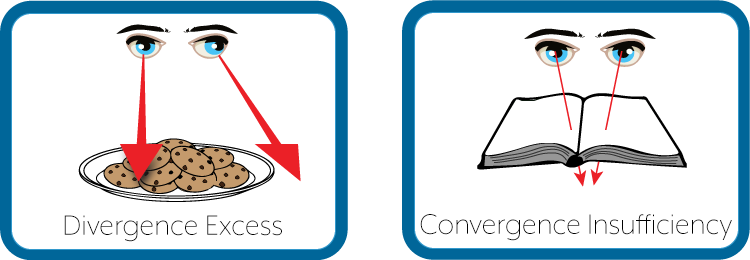Convergence Disorders

Problems with the vergence system fall into two major categories: problems at near (e.g., convergence insufficiency or convergence excess) and problems at distance (e.g., divergence excess or divergence insufficiency).
Convergence and divergence skills must be fast, accurate and consistent to maintain clear, single vision. Any form of vergence dysfunction can result in symptoms such as double vision, blurred vision, headaches or visual discomfort. Additionally, vergence dysfunction disrupts the visual-vestibular system, which can cause dizziness and balance difficulties.
Fortunately, disorders of vergence often respond well to vision therapy. Vergence therapy often begins by working at the distance where a patient is able to easily maintain fusion (or single, comfortable vision). Special lenses, such as prism lenses, may be used to help the patient learn to maintain fusion when eye position is altered. Other tools such as vectograms (3D images), a Brock string, or virtual reality games may also be used to help teach a patient's visual system to make appropriate eye movements at distance and near. It is not uncommon for a patient with a vergence disorder to also struggle with accommodation (the focusing system of the eyes). Once a patient does well with eye movement, therapy often progresses to the use of minus and plus lenses to stress BOTH eye position and focal ability. The end result is a fast, accurate, vergence and accommodative system and a resolution of symptoms!
What Causes Convergence Disorders?
The most common cause is abnormal eye position. No, this isn't a severe or noticeable eye turn (called a tropia, squint, or strabismus), more often this a normal, slight misalignment of the eyes called a heterophoria or "phoria". Most people have a small misalignment of the eyes (phoria) that isn't visible when you look at them. An eye doctor performs a cover test during an eye exam. This test checks how well the eyes align when one eye is occluded. Patients with a high phoria often have eyes that turn outwards during a cover test (called exophoria) or inwards (esophoria). During normal viewing, the brain coordinates the movement of the 6 extraocular muscles of each eye so that the two eye point together at the target of interest (say, a book when reading).
For short amounts of time, the brain is able to help keep both eyes nice and steady and pointed at the same target. But, a problem occurs if the eyes naturally want to rotate outwards or inwards AND the brain's ability to coordinate all the muscles starts to fatigue. The end result is symptoms such as eye strain, blurry vision, double vision and the like. This progression from a phoria to symptoms is often referred to as a "decompensated phoria" - think of this as the visual system is unable to "compensate" for the phoria.
Another common cause of convergence disorders is a traumatic brain injury. A head injury can disrupt normal nerve impulses, leading to poor eye teaming/coordination and myriad of eye movement disorders, convergence disorders included.
Does Eye Surgery Help Vergence Disorders?
It's quite rare for eye surgery to be needed for vergence disorders. Vergence disorders as a group often respond very well to non-surgical vergence and accommodative therapies.
What Should I do if I Have a Convergence Disorder?
The absolute best first step is to have a thorough eye examination. An eye doctor will look at visual skills (such as stereopsis, convergence and divergence, and eye teaming) and also eye health. You may be referred to someone that specializes in treatment of eye movement and vergence disorders. A coordinated treatment plan is the best course of action. An eye doctor that specializes in vision therapy can help create a treatment plan for you that is tailored to your visual needs.
The Vision Wiki
- Lazy Eye
- History of Lazy Eye
- Convergence Disorders
- Convergence Insufficiency
- Exophoria
- Esophoria
- Medical Terms
- Accommodation Disorders
- Accommodative Esotropia
- Accommodative Insufficiency
- Amblyopia
- Lazy Eye in Adults
- Strabismic Amblyopia
- Refractive Amblyopia
- Anisometropia
- Critical Period
- Strabismus
- Anomalous Retinal Correspondence
- Transient Strabismus
- Exotropia
- Esotropia
- Hypotropia
- Hypertropia
- Eye Problems
- Binocular Vision
- Physiology of Vision
- Lazy Eye Treatments
- Reading
- Fields of Study
- Research
- Glaucoma
- Virtual Reality
- Organizations
